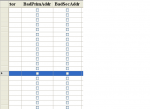I have a boolean column. Originally, it would show up in my VB.Net grid as checkboxes.
The checkboxes are no longer showing as a result of the following change of code. To avoid nulls, I now do it like this:
IIF(Attended IS NULL, False, Attended)
Instead of checkboxes, I now get a column of zeroes, as though the result is no longer boolean. I even tried this:
SELECT cBool(IIF(Attended IS NULL, False, Attended))
But I still get zeroes instead of checkboxes.
(I tried the NZ function but it was throwing "Undefined NZ function" errors on one or more of my boolean columns).
Any ideas?
The checkboxes are no longer showing as a result of the following change of code. To avoid nulls, I now do it like this:
IIF(Attended IS NULL, False, Attended)
Instead of checkboxes, I now get a column of zeroes, as though the result is no longer boolean. I even tried this:
SELECT cBool(IIF(Attended IS NULL, False, Attended))
But I still get zeroes instead of checkboxes.
(I tried the NZ function but it was throwing "Undefined NZ function" errors on one or more of my boolean columns).
Any ideas?

